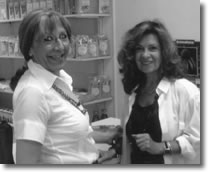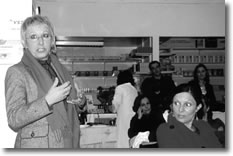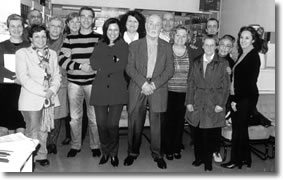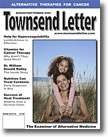A case of pancreatic cancer with large abdominal metastases and multiple liver metastases, diagnosed in 2005, is considered clinically cured in April 2009 by the Portuguese Institute of Oncology.
Introduction
Pancreatic cancer has a poor prognosis, with only about 2.5% survival to 5 years.1 The disease is extremely resistant to chemotherapy, radiotherapy, and surgery; potential cure may only be limited to about 20% of patients. Surgery itself is complex and difficult with a low record of success.2
To date, pancreatic cancer is still an enigma: alcohol, coffee, smoking, and a high-fat diet may be associated with the disease; but nothing is sure. However, my own observation and research in the field of embryology support the fact that the pancreas is connected with several nervous systems which not only reach the brain but are actually initiated in the intestine as "sensory nerves." The enteric nervous system is connected to the brain, pancreas, and colon; and in my opinion, many cases of pancreatic cancer have a deep nerve and stress connection. (A more complete explanation is available in my "Protocol of pancreatic cancer" at www.sergejurasunas.com.)
Treatment
The disease is particularly difficult to treat since 80% of patients present with advanced diagnosis and metastases. The tumor evolves quickly, activated by several factors such as the oncogenic forms of the Ras gene, which is most frequent and overexpressed in pancreatic cancer and plays an important role in multiple signal transduction cascades to activate tumor growth.3,4 The enzyme cyclooxygenase 2 (COX-2) is another factor overexpressed in pancreatic tumors – increased by up to 90%, compared with 40% to 60% in breast tumors. Overexpression of COX-2 induces the angiogenic cascade, impairs immune function, and downregulates apoptosis, a crucial key in tumor promotion.5,6 Excess ROS activity can turn up the nuclear factor kappa B (NF-kB), boosting inflammation, which in turn induces apoptosis resistance and metastasis invasion.7 A hypercoagulable state and thromboembolic disease are common complications of pancreatic cancer, which is not only linked to clinical manifestations including deep venous thromboses, pulmonary embolism, arterial thromboembolism, etc., but might also be related to enhanced tumor growth and angiogenesis.8 Initiation of the coagulation cascade leads to activation of angiogenic signaling pathways.
Therefore, new strategies are critically needed to target the tumor in many directions as possible as to inhibit angiogenesis, increase the immune defense, inhibit COX-2, and inhibit apoptosis induced by p53 to increase cancer cells' destruction.9,10
Clinical History
The patient, a Caucasian female of 52 years, a professor of pharmacy, involved in research with a busy life, was diagnosed in November 2005 with an advanced metastatic pancreatic cancer. Three years previously, her husband had developed cancer and, under the stress, the patient, who had never smoked before, started smoking and continued up to the death of her husband. Six months later, she was diagnosed with cancer.
The patient in 2006 at the beginning
of her treatment in our clinic. |
 |
Histology: Grade IV; head of pancreas, 4 cm lesion; multiple metastases to liver up to 3 cm; and large abdominal pelvic neoplasic mass.
Biology: Blood parameters, antigen tumor markers.
Surgery: None.
Chemotherapy: Oxiplatine, germicitabine, etc.
Imagery: PET scan.
The patient came to our clinic, demonstrating a very agile mind and determination to treat herself using all means within the field of alternative medicine. She understands the gravity of the disease and was looking to at least increase her median life extension and quality of life. She arrived in weak condition; she had been undergoing aggressive chemotherapy and suffered strong side effects, including pain, nervousness, anorexia, fatigue, depression and anemia.
Alternative check-up: Peripheral blood analysis; oxidative stress test (FORM); electromagnetic field test.
The Combination Therapy
Our treatment of pancreatic cancer is based on accumulated experience with all types and grades of cancer, but also in the attempt to increase patients' lifespan.
1. Ukrain
3 ampoules of 5ml IM per week (or IV).
Time: 2 months with a then delay of one month and again 2 months.
Judging from our experience, the natural chemotherapeutic agent Ukrain is most indicated in pancreatic cancer. In palliative treatment, Ukrain combined with chemotherapy can prolong life more than twice as long as chemotherapy alone.11 The longest survival in the gemcitabine group was 19 months, 21 months in the gemcitabine + Ukrain group, and in the Ukrain group a patient was still alive after 28 months.12 Among its effects, Ukrain induces apoptosis (through caspases pathways) and cell-cycle arrest in the phase G2/M. Ukrain penetrates directly to tumor tissue and DNA but not to healthy cells. Full remission of advanced local or metastatic pancreatic carcinoma after therapy with Ukrain has been reported.14-16
2. Liquid Cartilage Extract (LCE)
1 vial of 30ml of frozen liquid per day
LCE is critical to inhibiting the angiogenic cascade, which is strong in pancreatic cancer. For years, LCE has demonstrated strong efficacy against angiogenesis-inducing apoptosis of existing vessels.17
3. Biobran (RBAC)
One granule sachet of 1g three times per day
Biobran is a modified arabinoxylan extract derived from rice bran, cultivated on enzymes of shiitake mushroom, that shows strong immunomodulation property. Biobran is quickly absorbed by the body to activate NK (natural killer) cells up to 380% and boost T and B cell activity.18-20
4. Infla-Zyme Forte
6 to 8 tablets, three to four times per day
A mixture of proteolic enzymes in a high concentration together with bromelain papain and antioxidant enzymes as SOD (superoxide dismutase) and catalase. We found this special pancreatic enzyme mixture very effective for our cancer patients.
Pancreatic cancer induces a strong accumulation of fibrin, responsible for hypoxia and increasing angiogenic factors. Proteolitic pancreatic enzymes from bovine sources are necessary in order to inhibit or absorb excessive fibrin. Much work on cancer and pancreatic enzymes has been developed by Nicolas Gonzalez, MD, of New York, based on the work of embryologist Dr. John Beard of over 100 years ago. [See also Dr. Gonzalez's article– Ed.].21
5. Anoxe (low-molecular antioxidant compound having SOD-like activity)
16g to 24g per day
Developed through the work of Serge Jurasunas; see www.sergejurasunas.com.
Anoxe is a low-molecular antioxidant compound specially developed for therapeutic purposes, made from modified vegetables and seeds rich in antioxidants.22 It has strong effects against free-radical generation, inflammation, and COX1 and COX-2 activity.23,26 According to L. W. Oberley, overexpression of MnSOD in cancer cells with low MnSOD has been shown to have tumor-suppressive effects.24,25 Many new lines of investigation demonstrate that SOD is a tumor-suppressor equivalent to the P53 gene. Therefore, Anoxe may become a new anticancer agent by inhibiting antiangiogenic factors and inducing apoptosis. Our new line of clinical work with damaged or mutated P53 in cancer patients demonstrated that 3 months' therapy with Anoxe indeed activated P53 gene expression in cancer patients.27 We hope to have enough material in the near future to publish a complete report.
6. Anticancer food
The patient follows a strict diet commonly used in our institute for cancer patients. Recent studies have demonstrated that certain foods such as broccoli, curcuma, and onion retard or inhibit the growth of pancreatic cancer.28,29
Diet is a key factor in cancer recovery, and our regimen emphasizes fresh raw fruits, plenty of fresh green and yellow vegetables, sprouts, and steamed vegetables. Carrots, red beets, and most green vegetables should be made into fresh juice for a daily drink. The diet also relies on plant-based sources such as cereals, nuts and seeds, brown rice, and millet. Red meat should be eliminated, but fish and poultry may be eaten one or twice per week. Two meals per week should be only fruit and cottage cheese, three meals per week should include whole rice, and one day per week the patient should drink only mixed-vegetable juice divided in one large glass every 2 hours, taking some proteolic enzymes (Infla-Zyme Forte) with each glass.
On April 3, 2008, a new hospital check-up showed total elimination of abdominal metastases, including the multiple metastases to the liver, and significantly reduced size of the pancreatic tumor.
On July 7, 2008, a new hospital PET scan verified the total elimination of the pancreatic tumor and the remission of the cancer. The observation suggests elimination of the neoplasic malignancy.
In August 2008, the patient came to the clinic for a new consultation and alternative check-up. She was in good physical and psychological condition, and still taking Ukrain, Liquid Cartilage Extract, and Biobran but no further chemotherapy since having completed 80 sessions in November 2008. After this consultation, she stayed to participate in our regular "mind-body meeting," a new service for cancer groups; and she spoke about her own experience and how she had changed her lifestyle.
 |
The patient in November 2008 explaining to other patients about her experience with the disease. she adopted a new attitude to enjoy life; she began to entertain and go out dancing. In 2009, she bought a new car, began traveling and took up photography. |
The patient continued treatment and returned again to our clinic in October and at the end of November 2008 for two more mind-body meetings, a check-up including discussion of her health condition, and a medication refill. She spoke twice during the meeting and again in February 2009 before a large audience of cancer patients. She explained how she had decided to live every minute of her life positively, going dancing, doing yoga and meditation, traveling, and of course taking her treatment with the best possible spirit and have the best balanced and organic food possible.
In July 2009 the patient came again for a check-up and to discuss her life with me. She will do a new treatment with LCE (Comitris) and a 30-day course of Ukrain as routine prevention to keep her from any recurrence.
| February 2009: A group of cancer patients where our patient appears left (fourth position after me in the middle). From this photo, we observe that most patients are looking well and happy. |
 |
According to her last consultation at the Portuguese Institute of Oncology in April 2009, the patient's cancer was considered to be in total remission. After four years, we can acknowledge a victory using our combination therapy with chemotherapy to cure a most difficult case of advanced pancreatic cancer. Fewer than 10% patients survive 1 year after the diagnosis; therefore, we demonstrate the efficacy of our approach. We have also used this therapy with the same success in other types and grades of cancer, which you may have read about in previous issues of the Townsend Letter (2007, 2008).
In our clinical practice, we have used antioxidant compounds for many years to work synergistically with chemotherapy, obtaining excellent results – better than those from chemotherapy alone, including decrease of resistant tumors. Many doctors object to patients' taking antioxidants simultaneously with chemotherapy or radiation because it may decrease its efficiency.30,31 But, on the contrary, many new studies and clinical trials demonstrate that high doses of antioxidants are essential in improving the efficacy of standard cancer therapy.32 Antioxidants protect healthy tissues from chemotherapeutic agents and reduce toxic effects by 57% to 70%, improve patients' quality of life, and increase chemotherapy's effectiveness.
It has occurred to me that most doctors have limited knowledge about oxidative stress and cancer, how oxidative stress can clinically influence tumor growth. One would need a complete article, book, or three-hour lecture to explain the molecular targets of dietary antioxidants and how we can, for instance, stimulate apoptotic proteins such BAX and inhibit antiapoptotic proteins such BCL2. Thus these doctors have a poor notion of the wide field of therapeutic applications concerning antioxidants and/or other supplementations with the pathologies of cancer.
For more information, see my article "Integrative Oncology Denied the Efficiency Alternative Therapies and Antioxidants," Townsend Letter, August/September 2008 (online publication only).
Apoptotic Test of the Patient
P53 Protein Level – Elisa Assay
Result: 36,8u of (normal) P53 protein/ml of plasma
P53 Gene Expression
Result: 100 000 copies/ul of plasma (1000 copies/ul of plasma – associated with increased activity of a tumor suppressor gene P53)
This test clearly shows a high gene activity and a high protein production. It shows a tumor suppressor gene P53 in a normal condition (wild) with an increased production of the P53 (normal) protein, indicative of self-destruction of any abnormal cells, including cancer cells. In other words, if cancer cells are produced, the high activity of the P53 gene and the high protein level balance out through the self-destruction of cancer cells.
When the P53 gene is mutated, it produces a mutant (abnormal) P53 protein that is unable to trigger the self-destruction of abnormal cells.
Therefore, we regard the clinical status of the patient as being in remission and free from increased cancer-cell production. A recurrence would be linked with a decreasing production of P53 protein level or at worst a mutation of the gene.
Anticancer Food Pyramid (1.1MB .pdf)

About the author:
The author, a private researcher and clinician directing a modern clinic of integrative medicine, over the past 40 years has amassed considerable experience in how to approach and treat cancer. Serge Jurasunas has gained an international reputation as pioneer in naturopathy and integrative medicine, with contributions to iridology, medical microscopy, and theories on cancer, especially by developing innovative therapies. He teaches and lectures all over the world, and chairs many congresses such the International University of Integrative Medicine (Colombo). Serge Jurasunas has written more 100 documents, translated into 11 languages, and 6 books. As a pioneer, he was granted in 1996 the diploma of university professorship at Capital University of Integrative Medicine (US).
Over the years, cancer patients from all over the world have benefited from treatment at Holiterapias in Lisbon, Portugal. Beside being a researcher, Serge Jurasunas is a philosopher and spiritualist, now being the 76th Grand Master of the Sovereign Order of St. John of Jerusalem, Knight of Malta.
For more information:
Holiterapias
Rua da Misericórdia, 137 – 1º
1200-272 Lisbon – Portugal
Phone: +351 21 3471117
info@sergejurasunas.com

Notes
1. Jernal A, Tiwari RC et al. Cancer statistics, 2004. CA Cancer J Clin. 2004;54(8):29.
2. Sener SF, Fremgen A, Menk HR, Winchester DP. Pancreatic cancer: a report of treatment and survival trends for 100,313 patients diagnosed from 1985–1995, using the National Cancer Database. J Am Coll Surg. 1999;189:1–7.
3. Bos JL. Ras oncogenes in human cancer: a review. Cancer Res. 1989;49:4682–4689.
4. Almoguera C, Shibata D, Forrester K, Martin J, Arnheim N, Perucho M. Most human carcinomas of the exocrine pancreas contain mutant c-K-ras genes. Cell. 1998;53:549–559.
5. Yip-Schneider MT, Barnard DS, Billings SD, et al. Cyclooxygenase-2 expression in human pancreatic adenocarcinomas. Carcinogenesis. 2000-21-139-146.
6. Nakamari S, Yashina F, Murakami Y et al. Association of P53 gene mutation with short survival in pancreatic adenocarcinoma. Jpn J Cancer Res. 1995;86:174–181.
7. Arlt A, Gehrz A, Muerkaster S, et al. Role of NF-kB and Akt/PI3K in the resistance of pancreatic carcinoma cell lines against gemcitabine-induced cell death. Oncogene. 2003;22(21):3243–3251.
8. Palumbo JS, Kombrunk KW, Drew AF, et al. Fibronogen is an important determinant of the metastatic potential of circulating tumor cells. Blood. 2000;96:3302–3309.
9. Khan N, Afq F, Mukhtor H. Apoptosis by dietary factors: The suicide solution for delaying cancer growth. Carcinogenesis. 2007;28:233–239.
10. Masferrer JL, Leaky KM, Kobi AT, et al. Antiangiogenic and antitumor activities of cyclooxygenase 2 inhibitors. Cancer Res. 2000;60:13061.
11. Gansauge F, Ramadini M, Schwarz M, Beger HG, Lotpeich E, Poch B. The clinical efficacy of adjuvant systemic chemotherapy with Gemcitabine and NSC-631570 in advanced pancreatic cancer. Hepatogastroenterology. 2007;54:917–920.
12. Zemskow SV. Efficacy of adjuvant treatment with combination of Ukrain (NSC-631570) and Gemcitabine in cases of pancreas cancer. Ukr Chemother J. 2005;1.2.
13. Ramadani M, Gansauge S, Braumuller H, Scholosser S, Beger HG, Gansauge F. Selective induction of apoptosis in pancreatic cancer cell lines by NSC-63157. In: Chirurgisches Forum 2000 für experimentelle und klinische Forschung. 117. Kongreß der Deutschen Gesellschaft für Chirurgie, Berlin, 02.05.-06.05.2000, 79-83 (in German).
14. Gansauge F. Treatment of pancreatic cancer patients with Ukrain: four case reports. Int J Immunother. 2003;19(2–4):81–85.
15. Aschhoff B. Retrospective study of Ukrain treatment in 28 patients with unresectable pancreatic cancer. Int Immunother. 2003;19(2–4):81–85.
16. Kroiss T. Ukrain in the therapy of advanced metastatic pancreatic cancer: a case report. Int J Immunother. 2003;19(2–4):91–94.
17. Berbari P, Thibodeau A, Germain L, et al. Antiangiogenic effects of the oral administration of liquid cartilage extract. J Surg Res. Nov 1999;87(1):108–113.
18. Ghoneum M. Enhancement of human cells activity by an activated arabinoxylan from rice bran. Biochem Biophys Res Commun. 1998;243:25–29.
19. Lieberman S. A scientific review of the oncogenic effects of rice bran arabinoxylan compound (RBAC). Townsend Lett. May 2009;310:85–89.
20. Kaketani K. A case where an immunomodulatory food was effective in conservative therapy for progressive terminal pancreatic cancer. Clin Pharmacol Ther. 2004;14(3):273–279.
21. Gonzalez NJ, Isaacs LL. Evaluation of pancreatic proteolitic enzyme treatment of adenocarcinoma of the pancreas with nutrition and detoxification. Nutr Cancer. 1999;33(2):117–24.
22. Niwa Y, Kanoh T, Kasama T, Negishi M. Activation of antioxidant activity in natural medicine products by heating, brewing and lipoplulization: a new drug delivery system. Drugs Exp Clin Res. 1988;14:361–372.
23. Nair MG, Jurasunas S, Nelson T. Cyclooxygenase enzyme inhibitory property of Anoxe. National Food Safety and Toxicology Center, Michigan State University, Michigan, USA.
24. Oberley LW. Anticancer therapy overexpression of superoxide dismutase. Antioxid Redox Signals. 2001:461–472.
25. Oberley LW. Mechanism of the tumor suppressive effect of MnSOD overexpression. Biomed Pharmacother. 2005 May;59(4)143–148.
26. Jurasunas S. Therapeutic application of a new molecular antioxidant compound (Anoxe) in ROS activity. Int. Symposium on ROS and Nitrogenes Species, Diagnostic, Prevention and Therapeutic Values. 8–12 June, 2004; St. Petersburg, Russia.
27. Jurasunas S. PSJ-53 a new therapy to activate apoptotic pathway in a multicancer recurrence case. 2009.
28. Servan-Schreiber D. Anticancer: prevenir et lutter grâce à nos defenses naturelles. (Anticancer: To prevent and fight with our natural defenses). Paris: Robert Laffont; 2007:157–187.
29. Beliveau R, Gingras D. Foods that Fight Cancer. New York: McClelland & Stewart; 2006.
30. Vickers AJ, Phil D, Cassileth BR. Living proof and the pseudoscience of alternative cancer treatments. J Soc Integr Oncol. 2008;6(1):37–40.
31. Conklin KA. Dietary antioxidants during cancer chemotherapy: impact on chemotherapeutic effectiveness and development of side effects. Nutr Cancer. 2000;37(1):1–18.
32. Prasad KN et al. High doses of multiple antioxidant vitamins: essential ingredients in improving the efficacy of standard cancer therapy. J Am Coll Nutr. 1999 Feb 18;(1):13–25.
|



![]()
![]()
![]()




